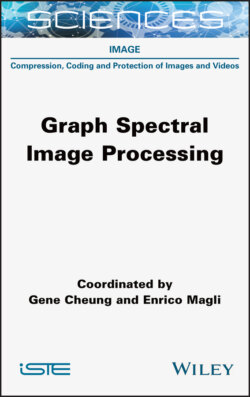Читать книгу Graph Spectral Image Processing - Gene Cheung - Страница 28
1.4.2. Edge-preserving smoothing
ОглавлениеEdge-preserving image smoothing is widely used for various tasks, as well as for image restoration (Nagao and Matsuyama 1979; Pomalaza-Raez and McGillem 1984; Weickert 1998; Tomasi and Manduchi 1998; Barash 2002; Durand and Dorsey 2002; Farbman et al. 2008; Xu et al. 2011; He et al. 2013). Image restoration aims to approximate an unknown ground-truth image from its degraded version(s). In contrast, edge-preserving smoothing is typically used to yield a user-desired image from the original one. The resulting image is not necessarily close to the original one.
In the graph setting, we need to define pixel-wise or patch-wise relationships as a distance between pixels or patches, and it is used to construct a graph. The following distances are often considered (Milanfar 2013b), where i and j are pixel or patch indices and is some nonnegative function:
1) Geometric distance: , where pi is the ith pixel coordinate.
2) Photometric distance: , where is the pixel value (often three dimensional) of the ith pixel/patch.
3) Saliency distance: where si is the ith saliency value.
4) Combinations of the above.
Figure 1.2. Comparison of approximation errors in . For a color version of this figure, see www.iste.co.uk/cheung/graph.zip
Saliency of the image/region/pixel is designed to simulate perceptual behavior (Itti et al. 1998; Harel et al. 2006). A popular choice of φ(·) is the Gaussian weight
[1.23]
where σ controls the spread of the filter kernel.
Suppose that the filter coefficients are determined based on the above features, and that they are symmetric, i.e. the output pixel value yi is represented as
[1.24]
where
[1.25]
Here, dk(·, ·) is one of the distance metrics mentioned earlier and K is the number of features we considered. The scaling factor Di normalizes the filter weights as . For example, the bilateral filter is K = 2 for dg(·, ·) and dp(·, ·).
The Fourier domain representation of such pixel-dependent filters cannot be calculated in a classical sense because it is no longer shift-invariant: the filter matrix W cannot be diagonalized by the DFT matrix. In contrast, GSP provides a frequency-like notion in the graph frequency domain. In general, the weight matrix W in equation [1.24] can be regarded as an adjacency matrix because all dk(·, ·) are assumed to be distances between pixels. Suppose that there is no self-loop in W, for simplicity. In general, the smoothed image in equation [1.24] is represented in the following matrix form:
[1.26]
where D = diag(D0,...,DN−1). This can be rewritten by using the relationship L = D − W as (Gadde et al. 2013):
[1.27]
[1.28]
[1.29]
where is a degree-normalized signal. Let us denote the eigendecomposition of Ln as . The above filtering in equation [1.29] is further rewritten as:
[1.30]
[1.31]
[1.32]
where y := D1/2y and the graph spectral filter is defined as Moreover, for the symmetric normalized graph Laplacian; therefore, it acts as a linear decay low-pass filter in the graph frequency domain.
This graph spectral representation of a pixel-dependent filter suggests that the pixel-dependent filter W implicitly and simultaneously designs the underlying graph (and therefore, the GFT basis) and the spectral response of the graph filter. In other words, the GSP expression of the pixel-dependent filter is free to design the spectral response , apart from the linear decay one, once we determine W. For example, let us consider the following spectral response:
[1.33]
where is an arbitrary graph high-pass filter and η > 0 is a parameter. In this case, works as a graph low-pass filter and its spectral shape is controlled by In fact, Gadde et al. (2013) show that equation [1.33] is the optimal solution for the following signal restoration problem:
[1.34]
where z = x + n with additive noise n and .
Image filtering sometimes needs numerous iterations to smooth out the details, in case of textured and/or noisy images. Therefore, to boost up the smoothing effect, the trilateral filter method (Choudhury and Tumblin 2003) first smooths the gradients of the image, and subsequently, the smoothed gradient is utilized to smooth the intensities. Its counterpart in the graph spectral domain is also proposed in Onuki et al. (2016) with the parameter optimization method for ρ in equation [1.33], which minimizes MSE after denoising it.
Figure 1.3. Image denoising example using bilateral filters. From left to right: Original, noisy (PSNR: 20.02 dB), bilateral filter in the pixel domain (PSNR: 26.23 dB), and bilateral filter in the graph frequency domain (PSNR: 27.14 dB). Both bilateral filters use the same parameters
Figure 1.3 depicts an example of image denoising by the bilateral filter in the graph frequency domain (Gadde et al. 2013). The image is degraded by additive white Gaussian noise. The bilateral filter in the graph frequency domain uses the spectral filter parameterized in equation [1.33], with ĥHPF = λ and η = 5. It is clear that the graph spectral version efficiently removes noise while preserving image edges.
